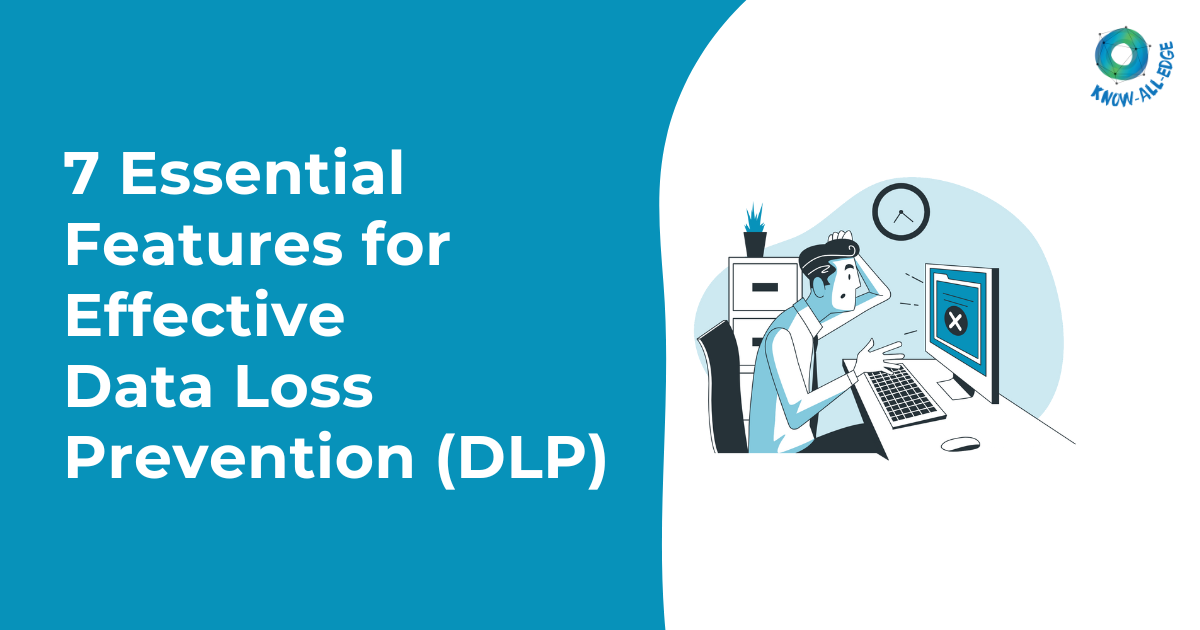7 Essential Features for Effective Data Loss Prevention (DLP)

3 Minutes 13 Seconds | 403 views
Listen This Blog Now!
Table Of Content
Table of Content
Introduction
7 Essential Features for Effective Data Loss Prevention (DLP)
- Content Analysis
- Data Lifecycle Management
- Data in Motion
- Data in Use
- Data at Rest
- Real-Time Analytics and Alerts
- Strategic DLP Strategy
Conclusion
Listen This Blog Now!
Table Of Content
Table of Content
Introduction
7 Essential Features for Effective Data Loss Prevention (DLP)
- Content Analysis
- Data Lifecycle Management
- Data in Motion
- Data in Use
- Data at Rest
- Real-Time Analytics and Alerts
- Strategic DLP Strategy
Conclusion
Introduction
In today's ever-evolving landscape of cyber threats and the constant presence of sophisticated hackers, data loss prevention (DLP) has become a crucial aspect of modern cybersecurity. DLP encompasses a set of technologies and processes designed to safeguard sensitive data, prevent unauthorized access, and ensure compliance with regulatory standards like HIPAA, PCI-DSS, and GDPR.
This blog explores seven must-have features that every effective DLP solution should possess to protect your organization's valuable information.
7 Essential Features for Effective Data Loss Prevention (DLP)
Content Analysis
A robust DLP solution should excel in content analysis, allowing it to thoroughly evaluate data using various methodologies. Content analysis involves categorizing data to apply appropriate security measures effectively. This includes capabilities like file cracking, enabling the system to decipher information even when it's deeply embedded within files or hidden behind encryption layers.
An effective DLP solution should understand different encryption types, ensuring that even encrypted files are subject to examination and appropriate action when necessary. This feature is crucial for preventing data leaks, even if data is maliciously or accidentally shared.
Data Lifecycle Management
Data has a lifecycle that spans various stages, including data in motion, data at rest, and data in use. A comprehensive DLP system should be capable of safeguarding data throughout its entire lifecycle. This means protecting data while it's being transmitted across networks, stored on devices, or actively used within applications.
DLP solutions should monitor data movement, apply policies, and enforce security measures consistently, ensuring that sensitive information remains secure regardless of its current state.
Data in Motion
Data in motion refers to information transmitted across networks or communication channels. An essential component of DLP is a network monitor, strategically positioned to capture and analyze network packets. This feature enables the detection of malicious data and the application of appropriate countermeasures.
Additionally, DLP solutions often include email monitoring tools, crucial for securing email communications, which are a popular method for sharing sensitive information.
Data in Use
Data in use pertains to information actively accessed and processed by applications or residing in device memory. DLP systems should be capable of monitoring and securing data in use, especially during activities such as data copying between applications or devices.
Endpoint protection is a critical aspect of DLP, ensuring data security on unmanaged or disconnected devices, such as employee laptops. While endpoint protection may not enforce all policies, it remains effective in safeguarding data on these devices.
Data at Rest
Data at rest refers to information stored on devices or servers that are not actively in use. DLP solutions should include a "content discovery" feature that scans various repositories, including laptops, servers, email servers, document servers, and databases. This feature allows for consistent policy enforcement across all data, whether shared, stored, or consumed across multiple systems.
For instance, you can establish policies preventing the transmission of credit card data over unsecured channels or email without prior encryption, and ensure it isn't retained on vulnerable devices.
Real-Time Analytics and Alerts
A dependable DLP system offers real-time alerts and analytics for protected data. Real-time alerts notify security personnel of potential security incidents, allowing them to take immediate action when necessary, particularly in the event of a severe data breach. Analytics and reporting options assist administrators in monitoring overall data security and evaluating the system's performance.
Many DLP solutions even offer customizable reports to align with your specific requirements, including compliance reporting for organizations subject to regulatory standards.
Strategic DLP Strategy
Beyond the technical aspects, a well-planned DLP strategy is vital for the success of a DLP program. Understanding your organization's business plan and identifying where critical data resides and how it's accessed are essential components of a successful DLP strategy.
A well-executed DLP strategy lays the foundation for a governance framework around data security, ensuring long-term protection for your business.
Conclusion
In an era of relentless cyber threats and evolving regulations, investing in a robust Data Loss Prevention (DLP) solution is imperative for safeguarding sensitive data and maintaining compliance. By ensuring your chosen DLP solution encompasses these seven essential features, you can fortify your organization's defense against data breaches and security vulnerabilities. Furthermore, a well-thought-out DLP strategy will provide the framework for a successful and enduring data security program.
Search Know All Edge